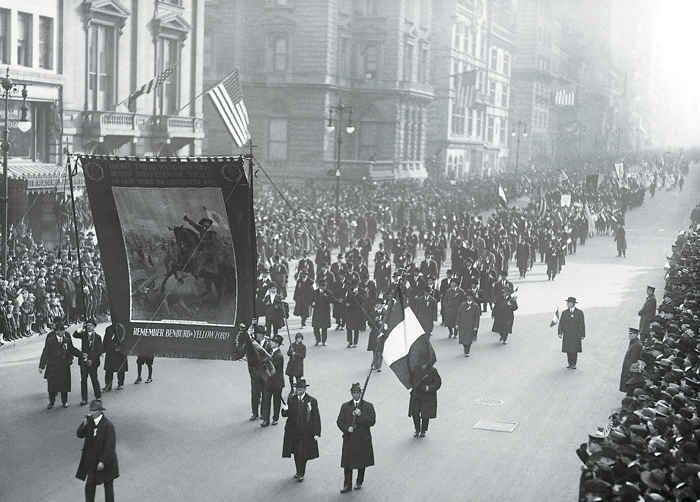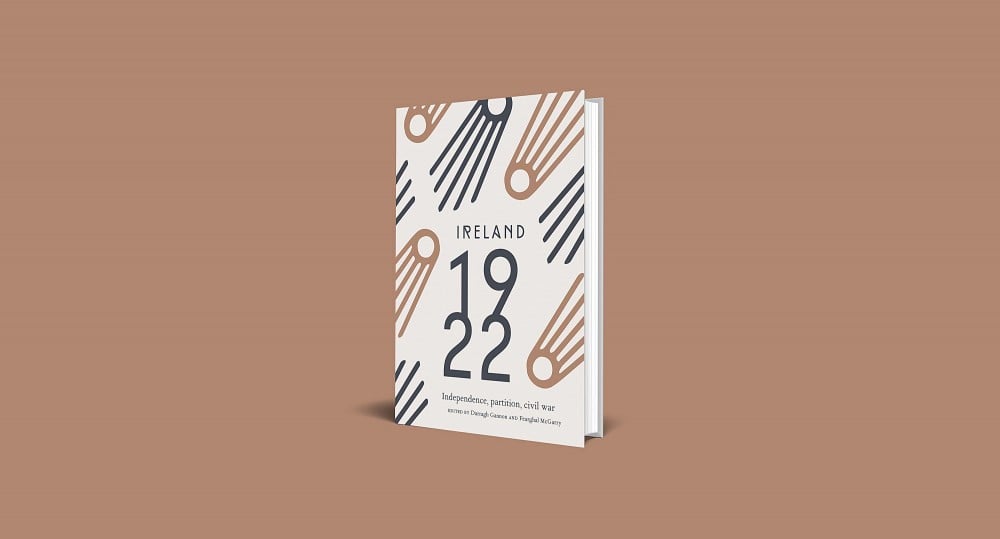17 March 1922: St Patrick’s Day, New York City
The ‘Scattered Children of Éire’: The Global Diaspora and Irish Identity
By Enda Delaney
On 17 March 1922 over 50,000 people marched in the New York St
Patrick’s Day parade, sending a strong message to the Irish
at home. The Anglo-Irish Treaty as negotiated with the British
government fell short of the expectations of the American Irish,
as the Grand Marshal Edward J. Gavegan outlined in a telegram to
Michael Collins, the head of the Provisional Government, to mark
the occasion. Collins had a message of his own,sending St
Patrick’s Day greetings and conveying the ‘Irish
Nation’s gratitude for the generous support given by America
through the long years of its struggle for freedom’.¹
Two years earlier it was very different, when unity was the theme.
The parade then was addressed by the president of the Irish
Republic, Éamon de Valera. De Valera urged that his Irish
American audience take an active role in securing Irish freedom
for the motherland:
Sons and daughters of the Gael! Wherever you be today, in the name of the motherland Greetings. Whatever flag be the flag you guard and cherish,it is consistent with your highest duty to link yourselves together to use your united strength to break the chains that bind our sweet sad mother and never before have the scattered children of Eire had such an opportunity for noble service. Today you can serve not only Ireland but the world.²
Across the world, St Patrick’s Day provided an opportunity for the exiled children of Éire to celebrate their Irishness, and more pointedly to consider what they could do to further the cause of Irish politics.This tradition began in the later nineteenth century and was the pivotal moment in the calendar for the Irish in the United States, Canada, Australia, New Zealand, Britain and many other places around the world.
When the new Irish state became independent in December 1922 it was distinctive in one critical respect. Not that a small revolutionary movement had managed to overthrow British rule, although that was a major achievement given the asymmetry of both military might and resources; not in the experience of the unity of the revolutionary movement fracturing and descending into civil war and fraternal conflict, as that happened in many independence movements; but in the existence of a large diasporic population estimated to number 1.76 million people scattered across the world.³ That figure did not include the children and grandchildren of those emigrants who had left Ireland, and could therefore be multiplied by a factor of at least two to calculate the number who would identify as being of Irish descent. This represented an enormous well of goodwill and practical support.
Between 1800 and 1921 over eight million people left Ireland. It was a land that, as the historian David Fitzpatrick memorably put it, ‘most people wanted to leave’.⁴ After the Great Famine of the 1840s somewhere between a half and two-thirds of those born in Ireland ended up emigrating (with some returning at a later date).
For many of these migrants, displacement and exile from Ireland did not result in a disconnection with the vexed politics of the homeland. From the 1798 rebellion onwards, prominent nationalist exiles became a vital source of inspiration for the diasporic Irish. The 1848 Young Ireland rising created important communities of radical nationalists in the United States, Canada and Australia, including leaders such as John Mitchel. The Fenian movement of the 1860s was largely, but not exclusively, a diasporic revolutionary organisation, as was its successor, Clan na Gael, in the later nineteenth and early twentieth century. The origins of the Fenian movement lay in Paris in the 1850s, where one of the leaders, James Stephens, took refuge after 1848.
Organisations such as Clan na Gael and its associated group, the Friends of Irish Freedom, mobilised Irish American support for the Irish republican movement between 1916 and 1922. Finance and fundraising were key activities, and to a large degree the Irish revolution was made possible by the money generated by diasporic nationalism, much to the irritation of the British authorities who closely monitored the activities of the exiled sons and daughters of Éireann.
But that is only part of the story. Historians now recognise that diasporic nationalism was a crucial feature in explaining the ultimate success of the Irish revolutionary movement and realising Irish independence. Leaders such as Michael Collins and Éamon de Valera recognised this, and Collins in particular was closely involved in the direction of the activities of the IRA in Britain. De Valera’s famous American tour of 1919–20 underlined the significance that Sinn Féin attached to the support of Irish Americans.
Support was about more than money. Irish nationalist organisations in North America, Britain and Australasia played another vital role—acting as conduits for information and publicity about events in Ireland, something that was especially important during the attempts by the British state to suppress Irish revolutionary violence in 1920 and 1921, using equally violent methods. British repression and atrocities committed by the Crown forces in Ireland were publicised by republican propagandists abroad to undermine British attempts to present events in Ireland as an ‘internal’ matter. International pressure initiated by Irish communities living abroad served to counter this partial presentation of events.
While the activities of diasporic nationalists in the United States are well known, new research has led historians to think beyond an exclusive focus on the United States and to consider how the Irish in Britain, Canada, Australia and even further afield in places such as Argentina were mobilised during the Irish revolution.
Why did Irish exiles respond with such enthusiasm, and in such large numbers, to calls to help the homeland in its time of dire need? Shared collective memory about the effects of British misrule, not least during the Great Famine when over one million people died, was a principal motivation. More so than other migratory groups, the Irish kept in close contact with events at home through letters and, by the end of the nineteenth century, repeated return visits home. So news about the late nineteenth-century Land War or the Easter Rising, or the effects of imposition of martial law by the British authorities in 1920–21, was more likely to fuel nationalist sentiment. Irish emigrant newspapers such as Irish World and the Boston Pilot carried extensive sections on events ‘at home’. Being distant in physical terms may have made revolutionaries of people who, in other circumstances, would not have got involved.
After 1922 the political role of the Irish diaspora remained important. Many defeated republicans left Ireland for the United States in 1923 and 1924, putting in place a bedrock for Irish diasporic republicanism in the twentieth century, to be reactivated in the late 1960s when the ‘Troubles’ broke out in Northern Ireland. Beyond activism, the diaspora has served as a source of political influence across the twentieth and twentieth-first century, especially so during the peace process in Northern Ireland and up to and including the present day.
Extracted from Ireland 1922 edited by Darragh Gannon and Fearghal McGarry and published by the Royal Irish Academy with support from the Department of Tourism, Culture, Arts, Gaeltacht, Sport and Media under the Decade of Centenaries 2012-2023 programme. Click here to view more articles in this series, or click the image below to visit the RIA website for more information.






















